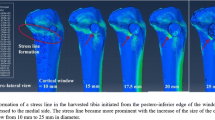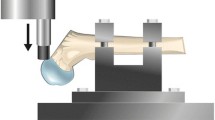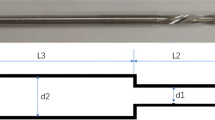Abstract
Introduction
Experimental studies on metaphyseal fractures are rare and do not control the biomechanical conditions in the healing zone. This study aimed to develop an improved experimental model, which characterizes and controls the biomechanical condition in the fracture gap of a metaphyseal fracture.
Materials and methods
A partial osteotomy model in the distal femur of the sheep was developed. The osteotomy was located in the region of the trochlea groove. The osteotomy gap was 3 mm wide. The retro-patellar force acting on the joint in vivo causes a bending of the trochlea resulting in a narrowing of the osteotomy gap. To limit and control this interfragmentary movement, stainless steel plates of various thicknesses were implanted into the osteotomy gap. Forces acting on the trochlea were analyzed and a load-deflection curve of the model was determined in vitro. A pilot study on two sheep was performed using the new model with two different interfragmentary movements of 0.3 or 1 mm. Eight weeks, post-operatively, the sheep were sacrificed and undecalcified histology was performed.
Results
The biomechanical analysis of the joint forces and the in vitro load-deflection behavior of the trochlea revealed that the forces acting on the trochlea were high enough to cause an interfragmentary movement of 1 mm in the osteotomy gap. This was confirmed by an X-ray of the sheep, which showed a closing of the proximal osteotomy gap under weight-bearing conditions. The histological section revealed no external callus formation. The sheep with the 0.3 mm interfragmentary movement showed almost complete bridging of the osteotomy gap with woven bone whereas the sheep with the 1 mm interfragmentary movement exhibited new bone formation only at the borderline of the osteotomy but larger areas with connective tissue or even fibrous cartilage in the center of the gap.
Conclusion
This metaphyseal bone-healing model provides defined and adjustable biomechanical conditions. The histological images demonstrated intramembranous and endochondral bone healing in the osteotomy gap without callus formation. The model therefore seems appropriate to study metaphyseal bone healing under differing mechanical conditions.






Similar content being viewed by others
References
Bergmann G, Graichen F, Rohlmann A (1999) Hip joint forces in sheep. J Biomech 32:769–777
Claes LE, Wilke HJ, Augat P, Rübenacker S, Margevicius KJ (1995) Effect of dynamization on gap healing of diaphyseal fractures under external fixation. Clin Biomech (Bristol, Avon) 10:227–234
Claes LE, Augat P, Suger G, Wilke HJ (1997) Influence of size and stability of the osteotomy gap on the success of fracture healing. J Orthop Res 15:577–584
Claes LE, Heigele CA, Neidlinger-Wilke C, Kaspar D, Seidl W, Margevicius KJ, Augat P (1998) Effects of mechanical factors on the fracture healing process. Clin Orthop S355:S132–147
Claes LE, Eckert-Hübner K, Augat P (2002) The effect of mechanical stability on local vascularization and tissue differentiation in callus healing. J Orthop Res 20:1099–1105
Duda GN, Eckert-Hubner K, Sokiranski R, Kreutner A, Miller R, Claes L (1998) Analysis of inter-fragmentary movement as a function of musculoskeletal loading conditions in sheep. J Biomech 31:201–210
Duda GN, Sporrer S, Sollmann M, Hoffmann JE, Kassi JP, Khodadadyan C, Raschke M (2003) Interfragmentary movements in the early phase of healing in distraction and correction osteotomies stabilized with ring fixators. Langenbecks Arch Surg 387:433–440
Epari DR, Schell H, Bail HJ, Duda GN (2006) Instability prolongs the chondral phase during bone healing in sheep. Bone 38:864–870
Jarry L, Uhthoff HK (1971) Differences in healing of metaphyseal and diaphyseal fractures. Can J Surg 14:127–135
Kenwright J, Goodship AE (1989) Controlled mechanical stimulation in the treatment of tibial fractures. Clin Orthop Relat Res 241:36–47
Scammell BE, Roach HI (1996) A new role for the chondrocyte in fracture repair: endochondral ossification includes direct bone formation by former chondrocytes. J Bone Miner Res 11:737–745
Uhthoff HK, Rahn BA (1981) Healing patterns of metaphyseal fractures. Clin Orthop Relat Res 160:295–303
Yasui N, Sato M, Ochi T, Kimura T, Kawahata H, Kitamura Y, Nomura S (1997) Three modes of ossification during distraction osteogenesis in the rat. J Bone Joint Surg Br 79:824–830
Acknowledgments
This work was supported by the SYNOS Foundation, Bern, Switzerland and the German Research Council (DFG 77/16-1).
Author information
Authors and Affiliations
Corresponding author
Rights and permissions
About this article
Cite this article
Claes, L., Veeser, A., Göckelmann, M. et al. A novel model to study metaphyseal bone healing under defined biomechanical conditions. Arch Orthop Trauma Surg 129, 923–928 (2009). https://doi.org/10.1007/s00402-008-0692-9
Received:
Accepted:
Published:
Issue Date:
DOI: https://doi.org/10.1007/s00402-008-0692-9




